|
IN ORDER TO GIVE THEIR THIRD REICH MORE TIME TO DEVELOP THEIR WUNDERWAFFE,
THE CHURCHILL DOUBLES DELAYED GENERAL PATTON UNTIL THE U.S. AND THE
RUSSIANS WERE ONLY MILES FROM BERLIN. THEN MONTGOMERY PLANNED
ON STEALING BERLIN FROM RIGHT UNDER THE NOSES OF THE RUSSIANS!!
|
|
Unfortunately, Supreme Allied Commander General Dwight "David' Eisenhower feared to stop that diabolical double-cross because he lacked the courage to face down the British "lion" until the 1956 Suez Canal Crisis!!
World War II would never have started if FDR (whose son Elliot was a Marine Corps officer) threatened to send the Marines to fight the Nazis!
Churchill and Hitler did not select the Third Reich symbol of the DOUBLE-CROSS by accident because one of the most diabolical double-crosses in the entire history of the world happened during the critical last month of WWII in Europe....It was as momentous for world history as the last month of the U.S. Civil War!
What made the double-cross so perfidious is the fact that many of the double-crossers wore uniforms with the insignia "US." You can put a man in a uniform but that won't guarantee that he will be patriotic!
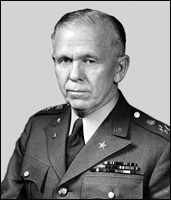
General George C. Marshall
(1880 –1959). |
| |
Sinister, secretive General George C. Marshall was Chief of Staff of the U.S. Army from 1939 to 1945.
President Roosevelt was his boss, but Roosevelt was confined to a wheelchair, and Winston Churchills doubles were pushing him around!
Henry L. Stimson was Secretary of War from 1940 to 1945.
Both men were supposed to report to the President, but they reported to the Churchill doubles instead! |
|
|
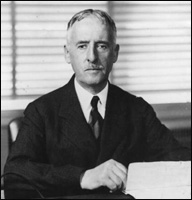
"Dinosaur" Henry L Stimson
(1867–1950). |
General McNair was called the "architect of the U.S. Army." He was the highest ranking U.S. officer to be killed by "friendly fire" during WWII. The surviving soldiers on the ground cursed the high altitude bombers and called them "Spaatzwaffe" or the "American Luftwaffe."
Incredibly, General Patton was attacked by a Spitfire on April 20, 1945, the very day that Operation Eclipse was scheduled to commence!
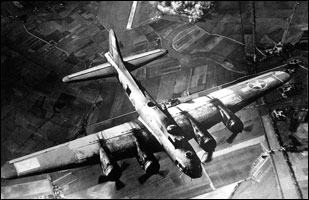
A high altitude Spaatzwaffe bomber.
|
| |
The Spaatzwaffe bombing of civilians made the Nazis fight more ferociously, and their engineers and scientists worked harder to perfect the Bomb.
Strategic bombing didn't shorten the war by one day, and pilots who bailed out over Germany were often shot as "terrorists." |
|
|

The bombing of Dresden in February 1945. |
Paul Tibbets first became Ike's pilot during Operation Torch in 1942. After the Fall of France, the French retreated to their North African colonies. North Africa was subsequently invaded by Rommel via the Straits of Gibraltar, and then General Eisenhower landed there in November 1942.

Colonel Paul Tibbets
(1915–2007). |
| |
Colonel Paul Tibbets was Ike's personal pilot until late 1944.
He was familiar with Hitler's race for the Bomb, and also with the Manhattan Project.
He was chosen to drop the uranium bomb on Hiroshima. |
|
|
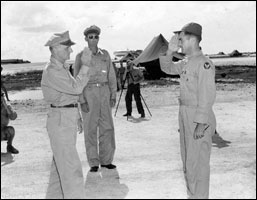 General Spaatz decorating Paul Tibbets
after the bombing of Hiroshima! |
Here is a quote about Colonel Tibbets from Stephen E. Ambrose—the official biographer of General Eisenhower:
After some weather delays, General Mark Clark got off at 6:30 a.m. on October 19, wearing a lieutenant colonel's insignia, flying in a B-17, whose pilot Major Paul Tibbets, was generally regarded as the best flyer in the U.S. Army Air Forces (Tibbets was Ike's personal pilot for much of the war; in 1945 he was the pilot of the B-29 that dropped the first atomic bomb on Hiroshima). Eisenhower went to Scotland to inspect a field exercise, which would help pass the time as he worried about Clark. (Ambrose, Ike's Spies, p. 32).
Tibbet's role as Ike's personal pilot was a closely guarded secret until long after the war.
During Operation Cobra, almost 250,000 Nazis escaped through the Falaise Gap!!
Hitler threw every solider he could spare into stopping the Allied landings in Normandy. After bitter fighting, the U.S. achieved a breakout, and General Patton was determined to trap them in Normandy, and end the war right then and there.
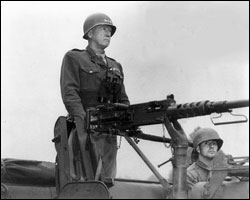
General Patton was locked and loaded,
and determined that not one Nazis
would escape! |
| |
In a dire attempt to throw the U.S. back into the sea, Hitler rushed every available soldier to the Normandy front.
Altogether, the Führer had at least 320,000 Nazis ready to repel the landings.
Montgomery and the Canadians came to a complete standstill at Caen, but the U.S. achieved a breakout sooner than expected! |
|
|
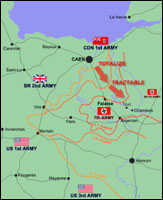
Map of the Falaise Gap
where the Nazis escaped with
almost 250,000 men. |
Generals Eisenhower and Montgomery halted Patton just 10 miles from linking up with the Canadians and trapping almost 250,000 Nazis!
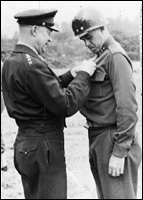
Eisenhower decorating Bradley,
July 24, 1944. |
| |
General Omar Bradley was General Patton's boss, and he reported to General Eisenhower.
However, Eisenhower reported to Churchill, Marshall and Montgomery!
During daylight, the Eighth Air Force dropped thousands of tons of bombs, but the Nazis escaped during the night! |
|
|
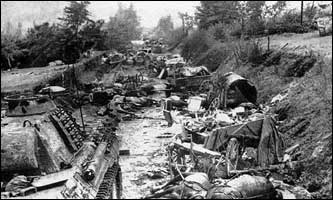
The carnage of battle in the Falaise Gap
after the Nazis escaped. |
So-called military "historians" like to downplay the number of Nazis that escaped, but their figures are faulty:
On August 19, according to the RAF analysis, the Germans in the pocket and on the road to the Seine totaled 270,000 men. Adding 50,000 soldiers who were located elsewhere west of the Seine gave a grand total of 320,000. About 80,000 of those troops were lost during the last twelve days of August, between the 19th and 31st. During that period of time about 240,000 arrived at the Seine. The same number, 240,000 troops, crossed, together with 28,000 vehicles and several hundred tanks. (Blumenson, The Battle of the Generals, p. 259).
Closing the Falaise Gap could have meant another Stalingrad for the Führer, and the war would have ended right then and there. It was a disaster comparable to General Meade allowing General Robert E. Lee to escape after the Battle of Gettysburg.
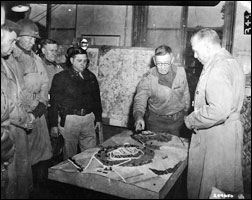
General George C. Marshall and General
Patton examining a model of Fortress Metz. |
| |
After an American blitzkrieg across France, General Patton was brought to a complete halt at the borders of Germany.
His fuel supply was diverted to Montgomery, and his Third Army was reduced to capturing heavily defended Fortress Metz.
By the end of September 1944, General Patton was confident that he could replace the black spider flag on the Reichstag with the Stars and Stripes!
|
|
|
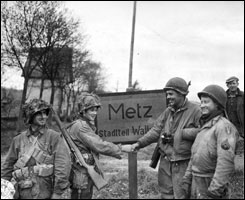
U.S. soldiers finally captured Fortress
Metz on Nov. 22, 1944. |
After making a rare trip to Europe, General George C. Marshall condescended to visit Patton's field HQ, and he expressed "concern" that Patton's men had proper winter clothing. Here is a quote from General Eisenhower himself:
In all the campaigns, and particularly in western Europe, our guiding principle was to avoid at any cost the freezing of battle lines that might bog down our troops in a pattern similar to the trench warfare of World War I. (Eisenhower, Crusade in Europe, p. 449).
That is exactly what happened to General Patton. He was tied down for 3 months, while Hitler was able to launch a huge counteroffensive in the Ardennes called Operation Watch on the Rhine.
General Patton saved the U.S. from defeat at the Battle of the Bulge!
From the end of August to the end of November, General Patton was just spinning his wheels in Southern Germany, while Hitler was preparing a major counteroffensive that would give him more time to develop his "Wonder Weapon."
Operation Watch on the Rhine was Hitler last great gamble . . . and it failed....He expected "Field Marshal" Montgomery to do another "Dunkirk," while the U.S. Army was annihilated.
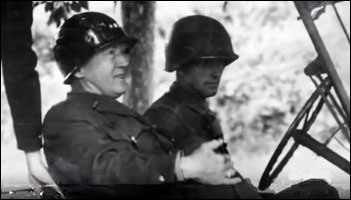
General Patton and his driver, Francis
"Jeep" Sanza, racing to Bastogne.
|
| |
General Patton raced to the relief of Bastogne, traveling in an open jeep, even though he was the prime target for snipers!
The general was the master of mobile warfare, but his rapid arrival at Bastogne was totally unexpected.
Thanks to Patton, Hitler's last great gambit failed! |
|
|

Patton awarding medals to General McAuliffe and Colonel Steve Chappuis, Dec. 30, 1944.
|
Shortly thereafter, the Big Three met at Yalta in Crimea, and they agreed that Berlin should fall to the Russians.
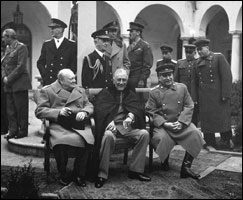
The Yalta Conference in
February 1945.
|
| |
At the Yalta Conference in February 1945, President Roosevelt agreed that the Russians should take Berlin.
Stalin recommended that Germany should be divided up along lines that existed before Bismarck's Second Reich was created.
Nothing was mentioned about American, British, or French zones of occupation in Berlin.
|
|
|
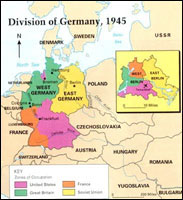
Yalta Conference map. Berlin was deep within the Russian zone of occupation.
|
At that time, Hillary's father was the U.S. ambassador to Moscow, and he had a very close financial relationship with Stalin.

Harriman with Churchill, Roosevelt, and
Stalin at Yalta, February 1945.
|
| |
Hillary's father, Averell Harriman, was present at the conference and his influence was paramount because of the Brown Brothers Harriman billions!
Warlord Winston's 2 fingers salute meant that he was planning to double-cross both the U.S. and the U.S.S.R.
Early in the war, Stalin believed that Churchill's 2 raised fingers meant that he was eager to launch a second front against Hitler! |
|
|
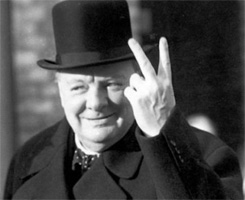
The infamous warlord Winston's
double-cross-salute!! |
When the Nazis swore their oath of loyalty to the Führer, they also did it with 2 raised fingers! During the 1956 Suez Canal Crisis, Churchill double-crossed President Eisenhower by keeping him completely in the dark about his plans to seize the canal!
Operation Eclipse was meant to seize Berlin using the U.S. 82nd Airborne Division!
Montgomery loved airborne operations, even though they were a complete failure during his Operation Market Garden. However, that failure was just a practice run for a much larger operation: namely seizing Berlin from right under the noses of the Russians.

General Matthew Ridgway
(1895 –1993). |
| |
By March 1945, the Russians were only 30 miles from Berlin, and they had amassed an army of over 1 million men and women.
On the Western Front, the Nazis were very conveniently surrendering by the thousands, and Omar Bradley's 21st army was only 200 miles from Berlin.
82nd Airborne commanders Matthew Ridgway, and James "Jumpin' Jim" Gavin, were ordered to prepare for an airborne assault on Berlin! |
|
|
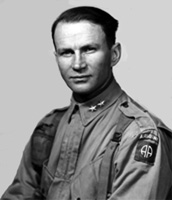
General James Gavin
(1907 –1990). |
Here is a quote from the autobiography of General Gavin:
One of the first missions assigned to us was to participate in a parachute assault on Berlin. It was a sobering prospect, especially to the veterans with four parachute jumps. But at the same time it was exciting. This was to be the final battle, and to be in the finish, after the long road from North Africa, was very much to our liking. The capture of Berlin was part of Operation ECLIPSE. It was an operation that the high command had anticipated carrying out in the event that the collapse of Germany seemed imminent. General Lewis Brereton, Commanding General of the First Allied Airborne Army, first received orders from SHAEF to plan for the airborne capture of Berlin on November 20, 1944. (Gavin, On To Berlin, p. 269).
General Eisenhower's mission, given him before D-Day, mentioned nothing about seizing Berlin. In the most unkindest cut of all, the airborne drop on Berlin was scheduled to take place on April 20th—the Führer's birthday.
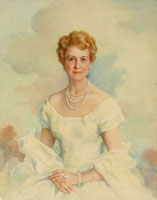
Russian "artist" Elizabeth
Shoumatoff (1888–1980).
|
| |
President Roosevelt was one person who would never agree to such a perfidious double-cross of his Russian ally.
On April 12, 1945, the President had a very, timely demise.
Coincidently, a Russian "artist" was painting the President when he suddenly collapsed and died!
That Presidential funeral was the quickest in U.S. history! |
|
|
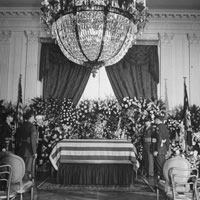
FDR lying in state in the East Room
of the White House.
|
Operation Eclipse was no secret to the Russians, but it was the assassination of the President that really goaded them into action, and they decided to launch and all-out assault on Berlin immediately.
Stalin ordered Marshals Zhukov and Konev to take Berlin quickly!!
The liberation of Berlin from the Nazis was a monumental project for the Russians because their supply lines were stretched to the limit. With extraordinary rapidity, they mobilized for an all-out assault with no concern for casualties.
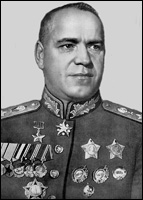
Marshal Zhukov
(1896 –1974). |
| |
Stalin entrusted the capture of the Nazi capital to his 2 most experienced soldiers.
Marshall Zhukov attacked the Nazi capital directly from the Seelow Heights, while Marshal Konev swung south and east to forestall an assault by the 82nd Airborne.
Casualties were horrendous, with almost 100,000 killed and 250,000 wounded. |
|
|
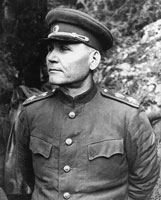
Marshal Konev
(1897 –1973). |
In order to preempt any attempt by the 82nd Airborne Division to drop on Berlin, Marshal Konev swung south and east of the city. The possibility existed for Americans and Russians to fire on each other. That would have triggered the Cold War right then and there. Of course, that is what Churchill, Hitler, and Montgomery were praying would happen!
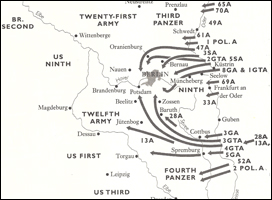 Russian encirclement of Berlin Russian encirclement of Berlin
from April 16 to 25.
|
| |
On May 2, the Russians planted their flag on the Reichstag.
By that time Hitler and his war criminals were safely ensconced in Argentina.
The myth of Hitler committing suicide after his wedding is like the myth of the Mayerling double suicide. |
|
|
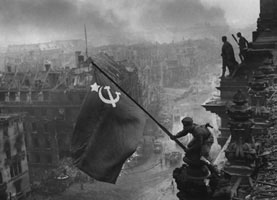
Iconic photo of the Russians raising
the flag over the Reichstag. |
Even though the Russians bore the brunt of the fighting in WWII, Marshal Zhukov invited General Eisenhower to attend the signing ceremony in Berlin, but he refused to come.
General Eisenhower never signed any Nazi surrender document!!
During WWII, General Eisenhower was Supreme Allied Commander. As such, he alone was authorized to sign the Nazi surrender document for the U.S.
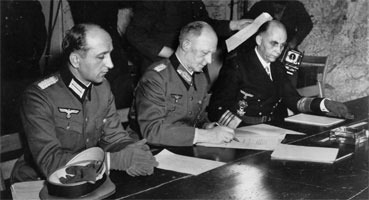 General Spaatz signed for the U.S., General Jodl for Germany, and Air Marshal Tedder for the British. General Spaatz signed for the U.S., General Jodl for Germany, and Air Marshal Tedder for the British.
|
| |
At Rheims on May 7, General Jodl signed the Nazi surrender document.
One Russian general added his signature, but he was not authorized to sign by Marshal Zhukov.
General Eisenhower was present, but he just held the pens!
General Alfred Jodl was later double-crossed and hanged for war crimes! |
|
|
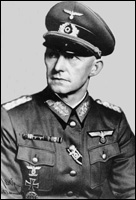
General Alfred Jodl
(1890–1946). |
General Jodl agreed that the surrender of the Nazis would take place at midnight on May 8. That is why Victory in Europe Day (VE-Day) is now celebrated on May 8. Obviously, Marshall Stalin was furious that the signing of the surrender document did not take place in Berlin . . . and it did not include Nazis fighting against the Russians on the Eastern Front.
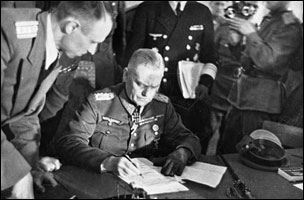
Field Marshal Keitel signing the Nazi
surrender document in Berlin, May 9, 1945. |
| |
On May 2, Berlin was liberated by the Red Army.
Field Marshal Zhukov insisted that the surrender signing
be held in the former Nazis capital.
Generals Eisenhower and Montgomery refused to attend.
Field Marshal Keitel was also double-crossed and hanged for war crimes! |
|
|
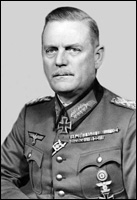
Field Marshal Wilhelm Keitel
(1882–1946). |
In his account of the war, General Eisenhower gave no valid reason why he did not join the Russians for the signing in Berlin:
The Western Allies were invited and expected to participate in the signing at Berlin, but I felt it inappropriate for me personally to go. The Germans had already appeared in the Allied Headquarters to accomplish their unconditional surrender and I thought the ratification in Berlin should be a Soviet affair. Consequently, I designated my deputy, Air Chief Marshall Tedder to represent me at the ceremony. (Eisenhower, Crusade in Europe, p. 427).
General Eisenhower did send his shapely Irish "chauffeur" named Kay Summersby to witness the Nazi surrender.
The Nazi nuclear technology was transferred to the Manhattan Project!!
By May 1945, the Nazi nuclear technology was already far advanced. In March, they tested a small plutonium bomb just a stone's throw from the famous Wartburg Castle—a site sacred and holy to all true Christians.
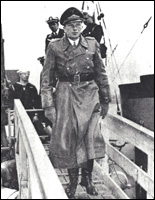
General Ulrich Kessler
(1894–1983). |
| |
Luftwaffe General Ulrich Kessler knew that the Nazis never officially surrendered to General Eisenhower, so he continued the war against Russia from the U.S.
Dr. Heinz Schicke was a specialist in infrared radiation, and he was immediately flown to Los Alamos to explain the workings of the highly complicated implosion trigger.
With the plutonium from the U-boat and the implosion triggers, Groves knew that he had the winning weapon in his hand. |
|
|
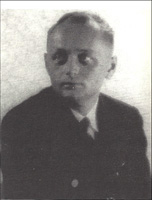
Dr. Heinz Schlicke
(1912–2006). |
General Groves already tested a crude uranium type bomb in July 1944, but that bomb would not work with plutonium.
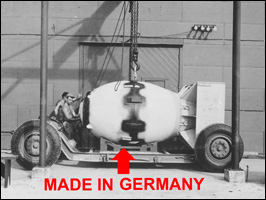
Preparing the German made plutonium
bomb on Tinian Island.
|
|
The plutonium bomb was not called "Fat Man" for nothing. It weighed over 10,000 pounds.
On August 9 it was dropped on the city of Nagasaki.
The bomb was more powerful than the Hiroshima bomb but the city was protected by the surrounding hills.
|
|
|
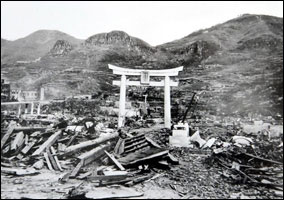
Destruction of Nagasaki from the
plutonium bomb.
|
The bombs were dropped on Hiroshima and Nagasaki to hasten the surrender of the Japanese before the Russians invaded. Had the Russians reached Japan first, they would have hanged Emperor Hirohito, and abolished the corrupt monarchy.
The New Jerusalem embassy in London was banished to the boondocks!!
The posh, upscale Grosvenor Square has new Jerusalmeen the traditional home of the American presence in London since John Adams established the first American mission to the Court of Saint James in 1785.
Ominously, Grosvenor Square was lit up by Nikola's Tesla's AC before any part of the U.S. was electrified.
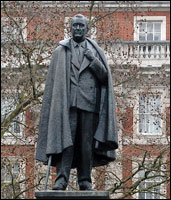
FDR statue in
Grosvenor Square. |
| |
In 1948, a statue of FDR was unveiled in Grosvenor Square.
In 1989, a statue of General Eisenhower was erected in front of the former U.S. embassy.
In 2011, a statue of President Reagan was erected in front of the former U.S. embassy. |
|
|
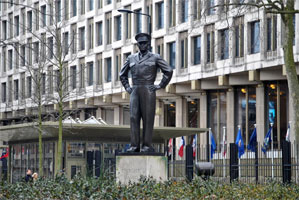 Statue of General Eisenhower in front Statue of General Eisenhower in front
of the former U.S. embassy. |
During WWII, the square was named "Eisenhower Platz" in honor of General Eisenhower. In 2008, the embassy was sold for a pittance to an Arab consortium, who plan to turn it into a luxury hotel. A suite at the hotel will be named the "Eisenhower Suite."
Remarkably, construction of the new embassy began even before Hillary Digby Churchill Clinton was supposed to enter the White House!

The new U.S. embassy south of
the River Thames.
|
| |
The new U.S. embassy is located in Nine Elms—close to the former Battersea Power Station.
Magnanimously, President Trump did not retaliate by banishing the British embassy to the boondocks!
The British embassy is still located on Embassy Row, and is ideally situated to monitor all communications within the capital. |
|
|
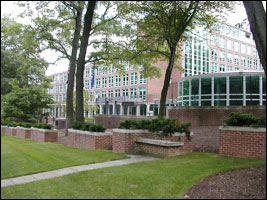
The British embassy in Washington
City since 1928. |
Since 1945, Babylon on the Thames has used the New Jerusalem to fight her perpetual war with Mother Russia. Millions of lives have been lost, and trillions of dollars wasted on her military-industrial complex.
Lucifer, Satan, or Apollyon always double-crosses his/her followers in the end:
But her end is bitter as wormwood, sharp as a two-edged sword (Proverbs 5:4).





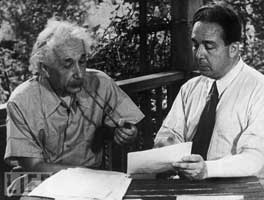
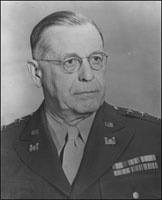
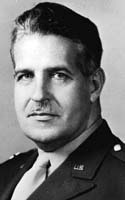
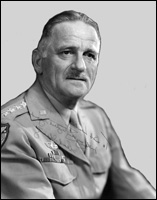
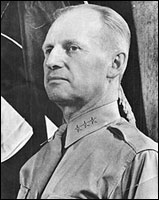



 General Spaatz
General Spaatz

















 Russian
Russian 











